Cindy rousted me out of bed by 9:30 because we had a big day ahead of us. We were going to take our first train across the river and out of Lisbon. Just a short trip today. 40 minutes to Palmela and then 5 minutes further to Setubol. Palmela is known for its Medieval castle with amazing views so we definitely wanted to check that out.
The train ticket process was a little confusing, but we had 20 minutes to figure it out before the train left. And we nailed it in 10. Every station has an information booth, but we've yet to see a booth with a person in it. Beside the booth is a kiosk with a few English words and far too many options. But there's often a helpful passenger to guide us.
Travelling around the greater Lisbon area is actually really easy and very cheap. There are lots of buses, four metro (subway) lines and the light rail trains to places like Sintra and Setubol. And all work with a single "Viva Viagem" card. You buy the card for 0.50€ and then load it up with money at kiosks around every station. For the metro, you scan the card when you enter the station and again when you leave; the fee for the ride is then deducted from your card.
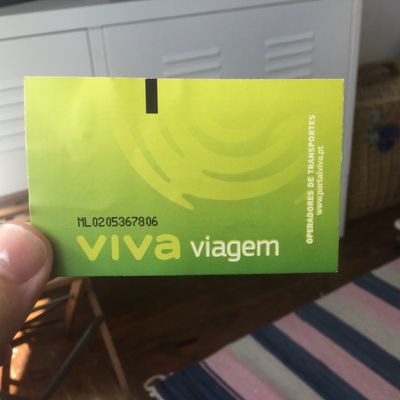
The extremely useful Via Viagem card
The challenge with trains is that you buy a specific fare at the kiosk, and you can't buy the fare if there are insufficient funds on the card. So load the card, then buy the ticket. But what if you don't know the fare? You go in circles, endlessly looping around the kiosk menu, until the person behind you in line takes pity and tells you the fare. 4.15€ to Palmela. And you can only by a one way ticket. You can go through all this again at the Palmela station.
Arriving in Palmela was hilarious, just like our trip to Belem. We looked out the window, saw the castle way off in the distance, and said "hey, we must be getting close." Then the train stopped. It seems that Palmela station isn't actually in Palmela! It's more on the far side of Aires, the town beside the train tracks. The castle looked very far away indeed, but we figured we were in good shape, so we tightened our shoelaces and started trekking.
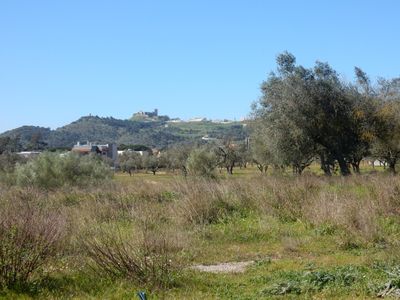
The castle is way up there? Well, better get walking!
Aires was nice. Tidy and colourful apartments with nice gardens. A modern school and smooth sidewalks. We were making good time.
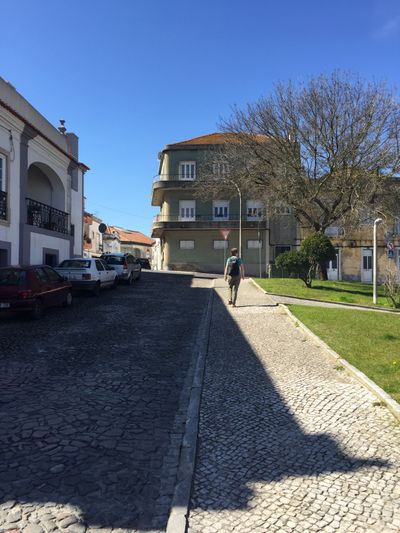
Walking through Aires. The castle road must be around here somewhere!
On the other side of Aires was the hill with the castle on top. Now how are we going to get up there? My maps.me app didn't show any access other than the main highway, so we headed on up. The road was busy and the sidewalk got narrower and narrower as the road got steeper, first heading away from the castle then switching back toward it. At its steepest, the road narrowed so there was no sidewalk, then no curb! Just a concrete drain beside the busy road. So we took to the drain. After about an hour of this all told, we arrived at the Palmela cemetary, then a side road where we could duck into town. We jogged into town and into a wonderland.

Palmela is a medieval hillside village that is still active and vibrant today. And it's beautiful. Windy cobblestone streets with shops and a market and a sun soaked view of the beautiful Barris Valley far below. We had just arrived via the back side of the village, that's all!
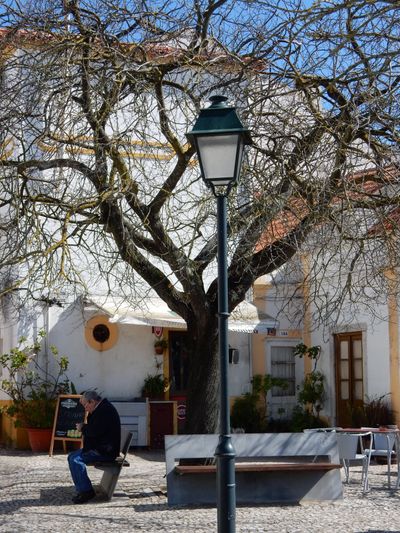
My favourite cafe in Palmela. It has the best view!
We stopped for a delightful lunch at a cafe and then walked across the street to a lookout, where we gazed back at the route we came up. The train station looked way off in the distance. And right in front of us was a wide white gravel road with two people trekking up to us. That looked much quicker! And hey, gravel roads are on my maps.me app too! More on that road later.
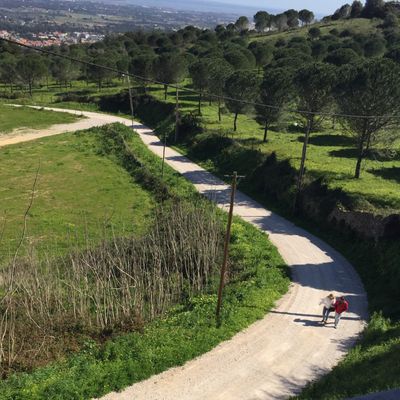
Hmm. Looks like a shortcut.
Rather than continue up to the castle right away, Cindy wanted to stroll through town first and find the market. So we weaved our way through the maze of streets and alleys until suddenly the view opened up and we got this amazing view of the Barris Valley. Beautiful! Sunny and green with an orchard to the right, forest to the left, and a winding road connecting tiny farms and vineyards in the middle.
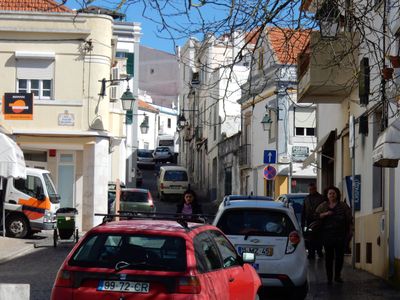
Bustling Palmela. But turn around and...
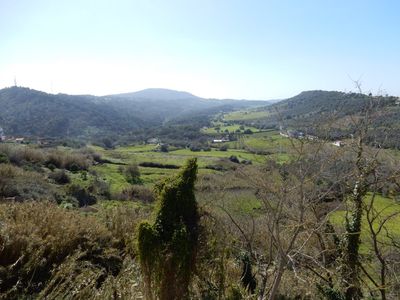
The Barris Valley. Lovely!
We grinned stupidly at each other forever. Grin to each other, gaze out at the valley below. Look back at the town. Grin to each other again.
After several minutes of grinning and gazing, a waiter from the cafe beside us came up with two glasses of wine from a man sitting at the cafe. I'm not kidding! We drank the wine (even Cindy, who never drinks red wine) and went over to thank the man, Tilak, and he introduced us to his daughter Rita and her partner Nuno. We visited a bit and Cindy show them her photo book of Regina life and then Tilak asked if we had 1/2 an hour and did we want to see more of the valley. Hell yeah! So we all piled into his 4x4 and drove out to the Barris Valley.

Palmela and the Castle from the valley floor
The valley is lived in and farmed but is also part of a protected area. The landowners and the government work together to keep the valley in its rural state even though there is pressure from Lisbon suburbs on one side an Setubal suburbs on the other. (As Tilak said, the government gives the protections and the landowners pay for everything.) But from the valley floor you forget about the cities on the other side of the hills. It's just wonderful country.
Rita drove us over a hill and into the neighbouring Arrabida valley, where they lived. Tilak bought his place 35 years ago and has been slowly turning his piece of the hillside into what he calls a Mediterranean nature preserve. He's got plants from all over the world there that grow well in the hot Mediterranean climate. Aloe plants from his native Africa. Over 17 species of bamboo from his time working in Asia. All planted in and around the native cork trees and other native plants on his hillside acreage.
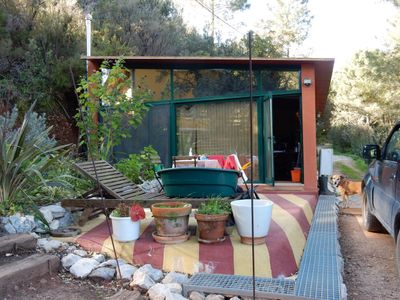
Rita and Nuno's place. Soon to be a holiday rental
Over the years he's also built a number of buildings on his land and they are now turning them into apartments to rent to tourists and house the fire brigade during the dry season. We toured the apartments and would gladly live in any one of them, for months or years. What a glorious place.
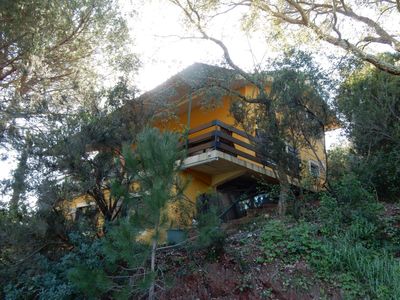
The first house. Rita grew up upstairs.
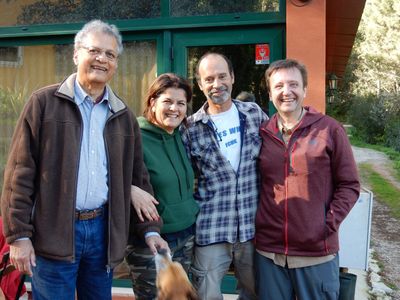
Tilak, Rita and Nuno, our new friends
Tilak had to get back to Lisbon so we said goodbye to our new friends and he dropped us off at the castle in Palmela at around 4pm. Oh right, the castle! I almost forgot why we went to Palmela in the first place! The good news was we had the place almost to ourselves at that time of day.
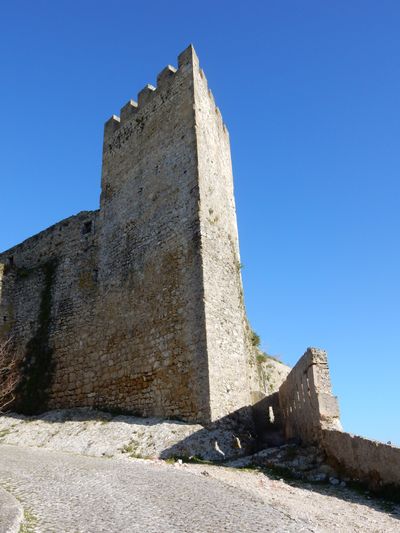
The nearly abandoned Castelo Palmela
We clamoured all over the castle. It's virtually untouched (I only saw one iron railing along extra steep stairs) and we could go all the way to the very top. No way the authorities would let you get right to the edge at home! It was thrilling.
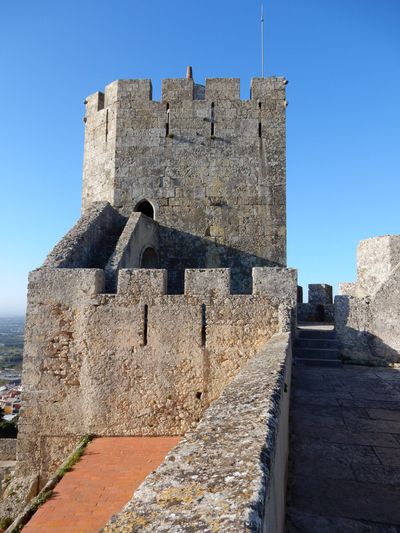
We were able to walk to the very top of the tower.
And the view was spectacular! You could see south to Setubol and across the inlet to the beaches of Troia. And then we turned north and could see Lisbon way off in the distance. Filipe told us this was a very strategic castle because of the view and I could really sense that.

Palmela from the top of the castle
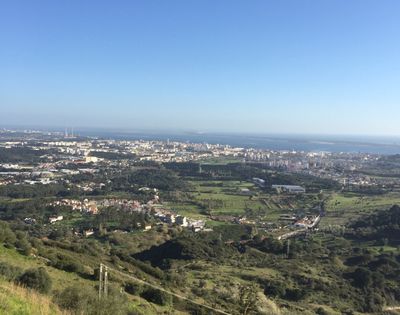
Setubol from the castle. Troia is across the water, then nothing but beaches and the Atlantic Ocean.
PS: This day seemed like it would never end, but this post has to. Cindy has her shoes on and it's time to get exploring again. Part 2 of our Palmela adventures will be posted soon!